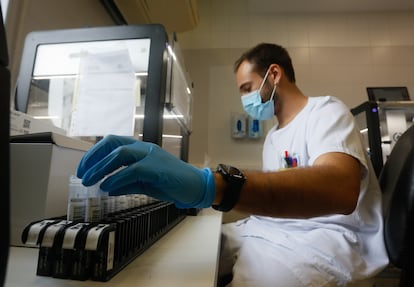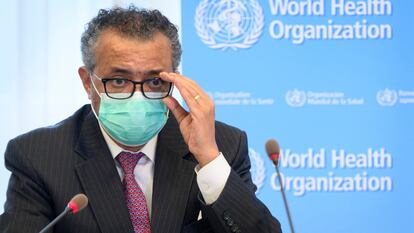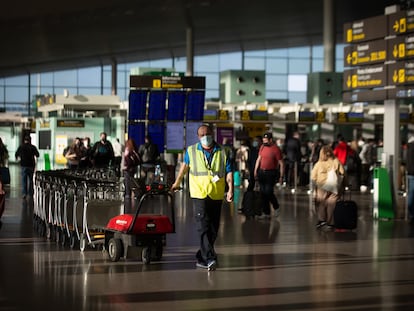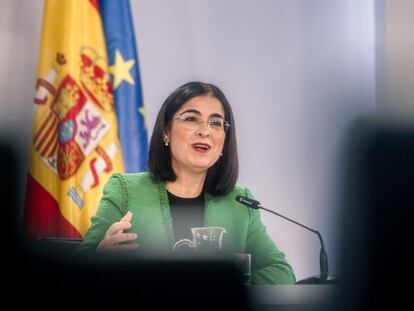First case of omicron variant detected in Spain, in traveler from South Africa
Spanish hospitals have already begun searching for the new strain of the coronavirus, using genetic sequencing as a benchmark but also PCR results

Spain is seeking to protect itself from the new variant of the coronavirus, which has been designated omicron. The mutations in the virus detected a week ago in South Africa and Botswana have been identified in half-a-dozen or so European countries, and Spanish hospitals are already searching for them.
On Monday, the microbiology department at the Gregorio Marañón Hospital in Madrid confirmed the first case detected in Spain so far of the new variant. It was found in a traveler who had arrived from South Africa. “We managed to use an ultra-fast procedure that permits us to get the result in the same day,” the hospital’s laboratory explained via its Twitter account. “The patient is doing well.”
As the search for this variant progresses, today the Health Ministry strengthened controls on all passengers arriving in Spain from the south of Africa: those traveling from South Africa, Botswana, Eswatini, Lesotho, Mozambique, Namibia and Zimbabwe will have to quarantine for 10 days.
Given the uncertainty over the effects of this new variant – for now it is unconfirmed as to whether it is more transmissible, causes more serious illness or could evade the protection offered by the vaccines – the Health Ministry has also strengthened controls for risk countries. Until now, anyone arriving in Spain from a country with growing infection numbers or where variants of concern are circulating had to show a certificate proving they have been vaccinated, have recovered from Covid-19 or have tested negative. From now on, according to an order published on Saturday in the Official State Gazette (BOE), arrivals “will be required, regardless of their vaccination status or if they have previously had the disease, to present a diagnostic certificate of active Covid-19 infection with a negative result.”
On Monday, another order was issued to put travelers from the aforementioned seven countries in quarantine on arrival in Spain, “with or without intermediate layovers.” “During the quarantine period, [travelers] must remain in their home or accommodation, limiting their movements, as well as access of third parties to the home or accommodation, to those essential for the carrying out of the following activities: acquiring groceries or pharmaceutical and essential products, attendance of healthcare centers, services and establishments, and for reasons of force majeure or situations of necessity,” the text reads. The order allows the quarantine to be reduced from 10 to seven days if a test comes back negative after a week.
At the same time, hospital laboratories in Spain are actively trying to locate the new variant. The European Union has called on member states to begin sequencing between 5 and 10% of diagnostic test results. This is the proportion that they consider sufficient to detect a mutation that is already circulating in a territory. Since August 9, Spain has sequenced around 5.9% of positive results, according to data from the Health Ministry. Depending on the week, the figure has swung between 2.5% to 8.5%. In a context of low diagnostic testing, as has been the case over this period, it is easier to sequence a high number of samples, given that this is a process that can take some days. When the wave of infections rises, hospitals can sequence a smaller proportion of cases.
As the sequencing process can take up to two days to complete given its complexity, current PCR tests can get ahead of this work by detecting the presence (or absence) in just a few hours of particular mutations in the analyzed sample. This allows for the suspicion that a new case detected could correspond to the variant identified a week ago in South Africa and Botswana.
The PCR test from the Thermo Fisher brand, for example, looks for mutations in three different parts of the virus. Juan Carlos Galán, the head of virology at Ramón y Cajal Hospital, explains: “The first information that we have indicates that a mutation of the new variant means that the PCR test does not detect the S gene. If a sample tests positive for that gene, then it is clear that this is not the omicron variant. But if you get a negative result for the S gene and a positive one for the other two targets, that allows for the suspicion that it is. This is a warning, an alert, although it can’t be ruled out that other variants could give the same result, meaning that genetic sequencing will always be necessary.”
Not all hospitals in Spain, however, use the Thermo Fisher PCR test, given that it is just one of those available in the market. Other large healthcare centers use other systems and some use several at a time. But the cumulative experience and the knowledge of how the mutations in each variant are combined allow for something approaching a trustworthy result. San Cecilio Hospital in Granada, which has the leading microbiology department for eastern Andalusia, developed another system that allowed for the identification of the delta variant by focusing on two parts of the virus.
Federico García, the head of microbiology at the San Cecilio, explains: “The results that we get with the delta variant, which currently account for more than 90% of positive cases, will be different with omicron, which lacks the target mutations used for delta. This would allow us to suspect an omicron case, although it would have to be confirmed via genetic sequencing, which is still the benchmark test.”
Tu suscripción se está usando en otro dispositivo
¿Quieres añadir otro usuario a tu suscripción?
Si continúas leyendo en este dispositivo, no se podrá leer en el otro.
FlechaTu suscripción se está usando en otro dispositivo y solo puedes acceder a EL PAÍS desde un dispositivo a la vez.
Si quieres compartir tu cuenta, cambia tu suscripción a la modalidad Premium, así podrás añadir otro usuario. Cada uno accederá con su propia cuenta de email, lo que os permitirá personalizar vuestra experiencia en EL PAÍS.
¿Tienes una suscripción de empresa? Accede aquí para contratar más cuentas.
En el caso de no saber quién está usando tu cuenta, te recomendamos cambiar tu contraseña aquí.
Si decides continuar compartiendo tu cuenta, este mensaje se mostrará en tu dispositivo y en el de la otra persona que está usando tu cuenta de forma indefinida, afectando a tu experiencia de lectura. Puedes consultar aquí los términos y condiciones de la suscripción digital.
More information
Últimas noticias
Maduro pleads not guilty before the federal court in New York: ‘I am still the president of Venezuela’
A new test can detect Alzheimer’s from a finger prick
UN team enters Sudanese city of El Fasher after paramilitary massacre: ‘It’s like a ghost town’
A recipe for resistance: Indigenous peoples politicize their struggles from the kitchen
Most viewed
- Gilles Lipovetsky: ‘If you want to live better and fall in love, take Prozac, don’t look to philosophy’
- Alain Aspect, Nobel laureate in physics: ‘Einstein was so smart that he would have had to recognize quantum entanglement’
- Alvin Hellerstein, a 92-year-old judge appointed by Bill Clinton, to preside over Maduro’s trial in New York
- Why oil has been at the center of Venezuela-US conflicts for decades
- Maduro’s downfall puts China’s relationship with Venezuela to the test











































